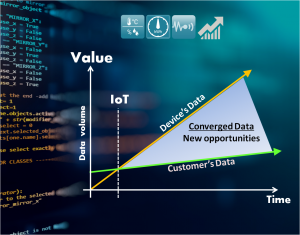Mobile network operator strategies for IoT
IoT has become a major focus area for mobile network operators worldwide. However, one fundamental question remains: Where are the real IoT business opportunities for MNOs to strategize and achieve volume, scale and growth?
First, let’s be clear — IoT is not just an isolated business segment, but it is an integral part of a bigger digital transformation strategy. Some operators are already in advanced stages with a mature IoT strategy in place, while others are lagging behind or somewhere in between.
It’s no secret that most mobile network operators (MNOs) face challenges in the commoditized voice and data markets while experiencing saturated subscriber growth. Additional challenges come from technology disrupters and global digital platform players that have become technology havens, attracting fresh innovation, large investments and financial market attention.
However, MNOs still have a solid position in regard to the ownership of their customers’ engagement, be it consumers or enterprises. MNOs will eventually be able to generate long-term IoT growth in the broader digital transformation landscape, where digitization has begun to transform a wide range of other industries.
First, let’s look at past lessons learned from two examples: media content monetization and mobile payment.
In the first example, leading MNOs realized how critical a media content strategy was to enabling growth and successfully moving up the value chain. Different enabling strategies were put in place, including the acquisition of media channels, the creation of partnerships and the building of media content delivery platforms. All of these have enabled MNOs to monetize, bundle new subscription-based services and generate higher data traffic on their networks.
In the second example, specifically in emerging markets, MNOs have created, through partnerships with the financial sector, new purpose-built payment services around their low ARPU customers to execute secured mobile payment transactions. These services have enabled a wide range of community-driven business models.
The main lesson learned from these two examples is that MNOs’ strong position in customer ownership and engagement combined with a deep understanding of market needs and dynamics has been key to driving new opportunities.
In the era of digital transformation, IoT is bringing a new set of data attributes that relate to devices and sensors associated with customer data in an ecosystem — let’s call this device data.
For example, one customer might have a car, phone, medical device and smart watch, and she may bike or use public transportation and she also visits the doctor, lives in a farm or smart city, travels, consumes electricity and water, and goes to work, school, shopping and so forth. All surrounding and embedded devices and sensors will generate a huge amount of data that relates to this specific customer in one way or another. The amount of device-generated data will surpass the customer’s data over time, and will both eventually converge.
 As the IoT market begins to mature, we will find the amount of converged customer and device data will form unique new IoT opportunities to explore. This converged data holds many promises for new opportunities and will proliferate in many day-to-day industries, such as healthcare, transportation, smart cities, utilities, retail, energy, smart living and wearables, in developing and developed worlds alike. In many cases, this converged data proliferation will also be driven by evolving community-based activities.
As the IoT market begins to mature, we will find the amount of converged customer and device data will form unique new IoT opportunities to explore. This converged data holds many promises for new opportunities and will proliferate in many day-to-day industries, such as healthcare, transportation, smart cities, utilities, retail, energy, smart living and wearables, in developing and developed worlds alike. In many cases, this converged data proliferation will also be driven by evolving community-based activities.
MNOs can play an essential role in using their customers’ and enterprises’ ownership by thinking in this way. This will also require putting strategic plans in place to enable user integration across multiple industries through IoT aggregation platforms, data integration tools, developer and API-centric services, secure authentication, on-demand capacity, data analytics and integrated flexible billing capabilities, to list a few.
Equally important, innovation to enable business integration, data contribution models and data sharing incentive mechanisms must be culturally motivated. With socioeconomics as the underlying baseline, MNOs can take a more active and leading role with regulators and data policymakers to adapt to a data-driven mindset. This will require further business and data integration capabilities with a service-oriented approach, enabling a cross-industry digital transformation and thereby creating new possibilities.
It’s important to note that this won’t happen overnight, but it surely will happen fast — depending on how quickly MNOs’ strategies are put in place and adapted.
All IoT Agenda network contributors are responsible for the content and accuracy of their posts. Opinions are of the writers and do not necessarily convey the thoughts of IoT Agenda.
